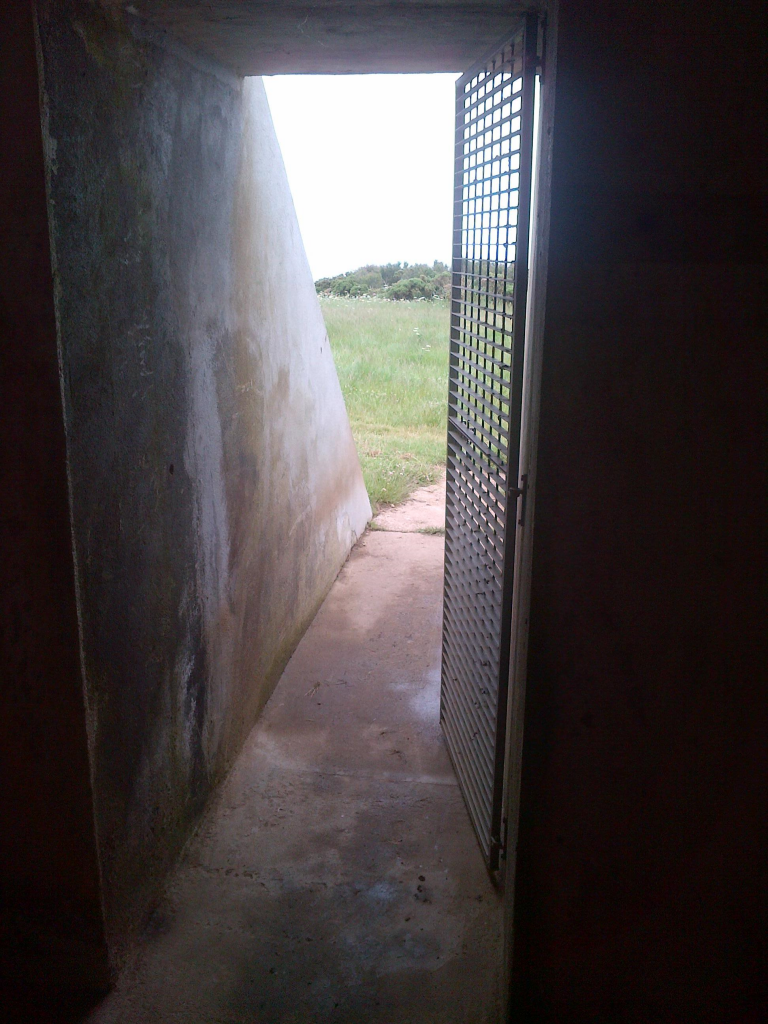Jackie Harding recounts walking across Gerrans Bay in Portscatho in summer earlier this year.
In this new regular series of features she will be mapping these kinds of stories onto the physical landscape of the Cornish coast. Read on to discover more.
Fuelled by a heady mix of childhood memories from my favourite 1970s TV series, Survivors – a traumatic viewing as an impressionable teenager of the banned 1965 television drama documentary The War Game and my subsequent peripheral involvement with Greenham Common protest groups in the early 1980s – I leapt at the chance to visit a nuclear bunker near Veryan.
We arrived just in time to plunge after our guide, Lawrence Holmes, into a stark military bunker near Nare Head. The walls were painted in nondescript 1940s paint and had an opening where a pipe used to be. There was a plinth and four metal spikes and small holes fitted with rawl plugs. It was cold in spite of the warm June sunshine outside.
The command room was reached by passing through a sunny porch; green moss, a big spider waiting on its web by a metal spiral ladder and a swallows’ nest, empty this year. Again, no furniture apart from a concrete bench; paint drips, drill holes and more rawl plugs were all that remained of the switch gear on boards which, we were informed, to my utter bewilderment, had operated leaking windows, fire boxes and escaping steam.
It took me a while to catch on. This bunker, it transpired, had been the command and control point of an imaginary place created during the Second World War by the special effects department of Ealing Film Studios.
From the air, at night, the quiet coast beneath became a decoy Falmouth, complete with railway station and buildings poorly blacked out (the leaking windows), designed to lure the Luftwaffe en route to Falmouth and trick them into bombing here instead of the actual docks. We had stumbled upon the remains of a place that had never even existed.

Back in the sunlight, surrounded by gorse, clover, thistles and ferns, a disturbed song thrush singing and winging overhead, I looked over the sea at an island shaped like a head. Talk of the Zeppelin Menace and the Royal Observation Corps drifted over my head.
Behind us there was evidence of another place that hangs between reality and the imagination; Carn Beacon, the largest Bronze Age Burial Mound in England. Legend tells that this ancient site holds a gold-plated barge that was buried in state with the ancient King Gerrenius whose body was brought over the sea from Dingerein (nearby Dingerrin Castle). No barge has been found but the story has persisted for over a thousand years.
Just to the North are the Iron Age works, the Ringarounds, but Carn Beacon held my imagination. This was part of the earliest nationwide communication system, dating perhaps from the Anglo-Saxon era, site of one of the fires that warned Drake and Raleigh of the approaching Armada, giving them time to complete their game.
Hauling myself back from the Bronze Age, through the Elizabethan Era, I noticed a series of strange pipes, contraptions and labels protruding from the heathland; “FSM Plastic Dome” , “BPI”, “Do Not Touch – Unexploded Maroon”.
Suddenly, I was in the Cold War. The bunker now below us had been blasted out of the igneous rock in 1963, just after Kennedy and Kruschev took us to the brink. Its purpose was to watch for rockets and to detect radio-active fall-out.
Sunk a metre underground, the nuclear bunker, decommissioned in 1991, is now fully restored, complete with Geiger counters, pressure valves, bomb power indicators, a petrol electric generator set, polystyrene tiles, rubber matting, dials and levers, telephones and radios and even a pin-hole camera system to map nuclear explosions.
In our digital world the analogue dials, like my mum’s 1960s kitchen scales, and a telescopic pole to poke through a hole in the ceiling to measure radiation, seem almost as far removed from us as the canons fired by Drake.
Billy cans, “No Smoking” signs, a plaque featuring knights in shining armour, government issue toilet paper decorated with a crown, large electrical instruments that look like sandwich toasters and tele-talk sets, are part of a different world.
I can just remember, out of the corner of my mind, those old visions of the future on black and white televisions and Saturday morning flicks, a world of Glitto Bleach and memory sticks, for those few in the know, that were memory bricks: computer technology in the analogue world.
Lawrence had been posted in a bunker like this and re-lived his life in front of us. Brave men would have been expected to venture outside to take readings post-nuclear attack wearing their naval duffel coats. There was no air filtration system, no heating, no fire arms.
Back on the heath, nature continues undaunted; poppies and hedge sparrows, yellow hammers and cow parsley, shoulder high.
Our walk this time had been through time itself, thousands of years in only a few hundred yards.
If you enjoyed reading this article, you can read Jackie’s previous entry for last month here.
Landscape photography by Rosie Beale, a mature student, who has completed her FdA English Studies at Truro College in Cornwall. She is now reading BA English at Plymouth University and is looking forward to a career in publishing and writing.
